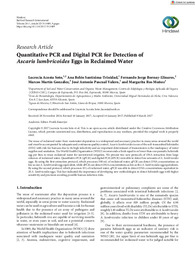Por favor, use este identificador para citar o enlazar este ítem:
https://hdl.handle.net/11000/34376Registro completo de metadatos
| Campo DC | Valor | Lengua/Idioma |
|---|---|---|
| dc.contributor.author | Acosta Soto, Lucrecia | - |
| dc.contributor.author | Santísima-Trinidad, Ana Belén | - |
| dc.contributor.author | Bornay Llinares, Fernando Jorge | - |
| dc.contributor.author | Martín González, Marcos | - |
| dc.contributor.author | Pascual Valero, José Antonio | - |
| dc.contributor.author | Ros, Margarita | - |
| dc.contributor.other | Departamentos de la UMH::Agroquímica y Medio Ambiente | es_ES |
| dc.date.accessioned | 2025-01-11T15:50:07Z | - |
| dc.date.available | 2025-01-11T15:50:07Z | - |
| dc.date.created | 2017-03-09 | - |
| dc.identifier.citation | BioMed Research International Volume 2017, Article ID 7515409, 9 pages | es_ES |
| dc.identifier.issn | 2314-6133 | - |
| dc.identifier.issn | 2314-6141 | - |
| dc.identifier.uri | https://hdl.handle.net/11000/34376 | - |
| dc.description.abstract | The reuse of reclaimed water from wastewater depuration is a widespread and necessary practice in many areas around the world and must be accompanied by adequate and continuous quality control. Ascaris lumbricoides is one of the soil-transmitted helminths (STH) with risk for humans due to its high infectivity and an important determinant of transmission is the inadequacy of water supplies and sanitation. The World Health Organization (WHO) recommends a limit equal to or lower than one parasitic helminth egg per liter, to reuse reclaimed water for unrestricted irrigation. We present two new protocols of DNA extraction from large volumes of reclaimed water. Quantitative PCR (qPCR) and digital PCR (dPCR) were able to detect low amounts of A. lumbricoides eggs. By using the first extraction protocol, which processes 500 mL of reclaimed water, qPCR can detect DNA concentrations as low as one A. lumbricoides egg equivalent, while dPCR can detect DNA concentrations as low as five A. lumbricoides egg equivalents. By using the second protocol, which processes 10 L of reclaimed water, qPCR was able to detect DNA concentrations equivalent to 20 A. lumbricoides eggs. This fact indicated the importance of developing new methodologies to detect helminth eggs with higher sensitivity and precision avoiding possible human infection risks | es_ES |
| dc.format | application/pdf | es_ES |
| dc.format.extent | 9 | es_ES |
| dc.language.iso | eng | es_ES |
| dc.publisher | Wiley | es_ES |
| dc.rights | info:eu-repo/semantics/openAccess | es_ES |
| dc.rights | Attribution-NonCommercial-NoDerivatives 4.0 Internacional | * |
| dc.rights.uri | http://creativecommons.org/licenses/by-nc-nd/4.0/ | * |
| dc.title | Quantitative PCR and Digital PCR for Detection of Ascaris lumbricoides Eggs in Reclaimed Water | es_ES |
| dc.type | info:eu-repo/semantics/article | es_ES |
| dc.relation.publisherversion | https://doi.org/10.1155/2017/7515409 | es_ES |

Ver/Abrir:
BioMed Research International - 2017 - Acosta Soto - Quantitative PCR and Digital PCR for Detection of Ascaris lumbricoides.pdf
360,31 kB
Adobe PDF
Compartir:
 La licencia se describe como: Atribución-NonComercial-NoDerivada 4.0 Internacional.
La licencia se describe como: Atribución-NonComercial-NoDerivada 4.0 Internacional.
.png)